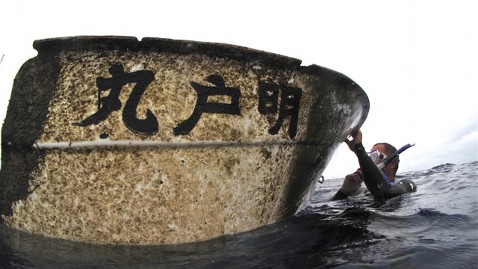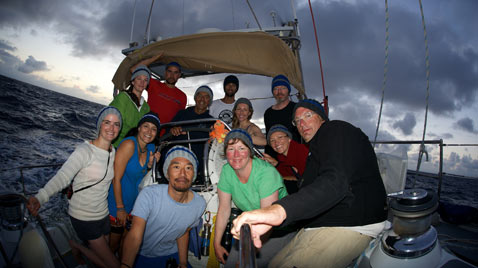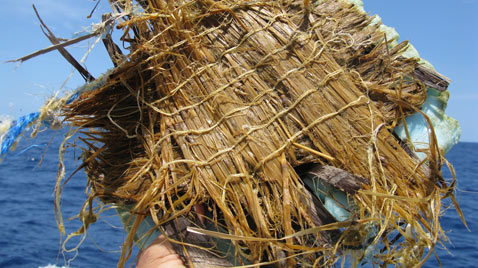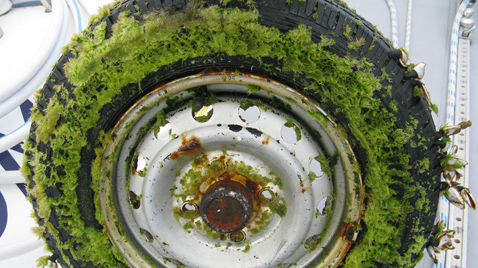Pacific Voyage Finds a Sea of Floating Tsunami Debris

(Photo by Stiv Wilson)
They were not signing on for a pleasure cruise, when Marcus Eriksen and 11 others climbed aboard the Sea Dragon in Tokyo a month ago.
The adventurers would sail over 4,000 miles of rough Pacific Ocean seas, finally limping into Hawaii this week, low on fuel and high on adrenaline.
The group was on a mission: looking to document any tsunami debris being pushed along by the current in the western half of the North Pacific.
"While we were doing this, we were very much aware of the tragedy," Eriksen told ABCNews.

(Courtesy 5 Gyres Institute)
Eriksen, who has devoted a dozen years to studying plastic trash polluting the world's oceans, says the tsunami also gives scientists a unique opportunity that they couldn't create themselves.
"You can't [just] take an entire city of all the materials we consume and put it in the oceans," to see what happens, he said.
Debris from the tsunami in March of 2011 has started coming ashore on the West Coast of the United States and Canada - everything from part of a huge dock that washed up on the beach in Oregon, to a soccer ball.

Chris Pallister/AP
Those pieces of debris were jutting high enough out of the ocean that they were driven eastward by the wind, but researchers on the 72-foot Sea Dragon were hunting for debris that was mostly submerged and subject to the ocean currents.
Their biggest find was half of a fishing boat, which Eriksen estimates was originally about 16 feet long. A quick dive underwater found a few barnacles and 50 or 60 fish living inside.

Alexander Tidd/U.S. Navy/NOAA
"What's now a wreck of a boat has become a floating reef system for this crowd," Eriksen wrote in his blog chronicling the journey.
He and his team are now working with the Japanese television network NHK to try to locate the owner of the fishing boat.
"My first question," Eriksen said. "Are you and your family, OK?"
He's hoping the boat was simply ripped from its mooring during the powerful tsunami and that no one was on board.

(Photo by Stiv Wilson)
Tsunami debris aside, the Pacific Ocean "is one giant garbage patch", according to Eriksen.
His non-profit group, the 5 Gyres Institute, works to reduce plastics polluting the oceans. (A gyre is a large circular ocean current.) This was his 12th expedition and also included cataloguing plastic debris.
"We are in the middle of nowhere, and we are seeing one piece of trash every three and a half minutes," said Eriksen.
A marine research institute, Algalita, will analyze the garbage samples, as part their mapping of plastic debris in the North Pacific Ocean.
In addition to the Japanese fishing boat, the crew also found other remnants of the tsunami, including a truck tire still on the rim, and a tatami mat which may have been a piece of flooring. They also spotted a metal propane tank, a fishing buoy and a blue plastic bucket.

(Photo by Stiv Wilson)
"My guess is there's not going to be a wave or avalanche of (tsunami) debris washing ashore," he said. "It is going to be a slow trickle over many years."
That slow trickle could still amount to quite a haul.
The Japan Minister of Environment estimated that 5 million tons of debris was washed into the ocean, and that about 70 percent of that sank near the coast of Japan. That leaves some 30 percent - 1.5 million tons of debris - that would have floated into the Pacific Ocean.
As the U.S. and Canadian governments continue to develop plans to handle all that oncoming debris, the 5 Gyres Institute is getting ready for its next mission. On Wednesday, a team heads out on a Lakes Expedition, for the first investigation of plastic pollution on the surface of Lakes Michigan, Huron and Erie.